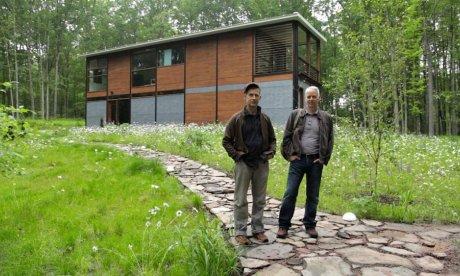House and Home

Family barbecue in Lakewood Plaza suburban development, Long Beach, California, ca. 1950. Architect: Chris Choate with designer Cliff May.

Family barbecue in Lakewood Plaza suburban development, Long Beach, California, ca. 1950. Architect: Chris Choate with designer Cliff May.
From condos and Cape Cods to ranches and dumbbell apartments, Americans have built all sorts of structures to call home. And with some help from humanities scholars and museum curators we can now learn how to read the buildings people live in as evidence of those occupants’ personal values and also as a reflection of the broader cultural ideals of our society. Throughout American history, our houses have taken many different shapes, sizes, and meanings. In a long-term exhibition, House & Home, the National Building Museum in Washington, D.C. explores the social, cultural, and artistic history of the American house. The exhibition takes us on a wide-ranging tour of homes both familiar and unexpected, through past and present.
This is more than just a story of architecture. Seven exhibition galleries feature: objects used to furnish homes from an Easy Bake Oven to a yarn swift; iconic house designs by Thomas Jefferson, Frank Gehry, and Frank Lloyd Wright; life-size wall sections demonstrating different construction techniques; and original films looking back at the social and cultural history of home life. We also see how Americans have paid for their homes with bank mortgages, FHA loans, and subprime loans. In the last gallery, visitors can watch films profiling six diverse American communities and explore the tough decisions made by developers, real estate agents, and residents. The featured communities are Summerlin in Nevada; Parkside of Old Town in Chicago; Musicians’ Village in New Orleans; LeDroit Park in Washington, D.C.; Coyote Crossing Cohousing in Santa Cruz, California; and Rumford Center in East Providence, Rhode Island.
“By exploring the diverse history of America’s homes, we can better understand our society’s priorities and possibilities, and, in turn, we can better understand ourselves,” explains Chase W. Rynd, the executive director of the National Building Museum.
Like most significant exhibitions, this one tackles a seemingly ordinary phenomenon and illuminates its larger significance, cultural meanings, and social history. It may well prompt visitors to think anew about their own experiences of home. So whether you live in a suburban McMansion, a studio apartment, or a rural farmhouse, House & Home will help you to see your way of living--and housing--as part of a complex story of how in our ordinary choices we all shape American history.
House and Home opened April 28 at the National Building Museum. For more information you may go to http://www.nbm.org/exhibitions-collections/exhibitions/house-and-home.html. Extensive public programming, and school programming accompany the exhibition.

